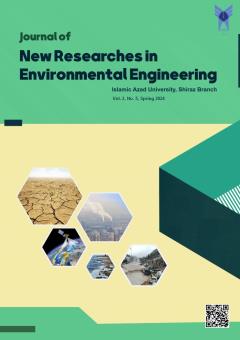Comparison the Phytoremediation ability of Pelargonium Graveolens and Brassica Oleracea Acephala in Removing Total Petroleum Pollutants and Heavy Metals (Lead and Cadmium)
Subject Areas : Environmental pollution
Shahrzad Khoramnejhadian
1
*
![]() ,
Samira Abedini
2
,
Samira Abedini
2
1 - Department of environment, Damavand Branch, Islamic Azad University, Damavand, Iran
2 - - Department of Environment, Damavand Branch, Islamic Azad University, Damavand, Iran
Keywords: Phytoremediation, Heavy metal, Petroleum Hydrocarbon, Soil,
Abstract :
|
Introduction: Soil pollution with petroleum hydrocarbons and heavy metals is one of the problems related to industrial societies. There are several methods to remove pollutants from the soil. Phytoremediation is a method in sync with the environment that uses plants to remove pollutants from the soil. The purpose of this research was to investigate the cleaning of soil from oil pollution and also heavy metals using two ornamental plants, ornamental cabbage and aromatic geranium.
Materials and Methods: 40 samples including 20 soil samples and 20 plants were selected. Soils were selected in three categories: clean (control), semi-contaminated and completely contaminated. Soils were selected in three categories: clean (control), semi-contaminated and completely contaminated. HPLC device was used to measure heavy metals. A spectrophotometer was used to measure the total petroleum hydrocarbons.
|
|
|
Results and Discussion: The highest amount of hydrocarbon accumulation in geranium in semi-contaminated soil is related to tetradecane (16.021 mg/Kg) in dry tissue and there was no effect of tridecane and pentadecane accumulation in fresh and dry geranium tissue. In ornamental cabbage, the highest amount of accumulation related to decan (19.69 mg/Kg) was seen in fresh tissue and the lowest amount of accumulation related to nonan (0.659 mg/Kg) was seen in dry tissue. |
|
|
Conclusion: The results of this research showed that both ornamental plants used in the research were suitable for herbal treatment. In removing oil pollution, the aromatic geranium plant showed a better performance. had. Ornamental cabbage had a higher efficiency in removing the heavy metal cadmium. |
Amiri, N., Yadegari, M., & Hamedi, B. (2018). Essential oil composition of Cirsium arvense L. produced in different climate and soil properties. Rec. Nat. Prod, 12(3), 251-262. DOI: http://doi.org/10.25135/rnp.27.17.06.043.
Bayrami N., Fataei E., Kharrat Sadeghi M., Javanshir Khoei A. (2020), Evaluation of bioaccumulation of lead metal pollutant in two biotic and abiotic compartments of the Caspian Sea coastal sediments. Journal of Marine Biology(In persian), 12 (3), 1-14.
Bouchez-Naïtali, M., & Vandecasteele, J. P. (2008). Biosurfactants, an help in the biodegradation of hexadecane? The case of Rhodococcus and Pseudomonas strains. World J. Microbiol. Biotechnol, 24, 1901-1907. DOI:10.1007/s11274-008-9691-9.
Dehghani,Mansooreh, Taatizadeh, Seyed Behnam, & Samaei, Mohammad Reza. (2013). Biodegradation of N-Hexadecane In Acinteobacter Radioresistern Liquid Culture. Health Scope, 2(3), 162-167.
Etsami Maral, Biabani Abbas, Suleimangli Ehsan. Plant breeding in sustainable agriculture. 2012. Available from: https://sid.ir/paper/883775/fa [In Persian] . Fataei E., Monavari S.M., Hasani A.H., Karbasi A.R., Mirbagheri S.A. (2010), Heavy metal and agricultural toxics monitoring in Garasou river in Iran for water quality assessment. Asian Journal of chemistry, 22 (4): 2991-3000
Ghavam, M. (2021). Relationships of irrigation water and soil physical and chemical characteristics with yield, chemical composition and antimicrobial activity of Damask rose essential oil. PLoS One, 16(4), e0249363. https://doi.org/10.1371/journal.pone.0249363.
Huang, X. D., El-Alawi, Y., Gurska, J., Glick, B. R., & Greenberg, B. M. (2005). A multi-process phytoremediation system for decontamination of persistent total petroleum hydrocarbons (TPHs) from soils. Microchem. J., 81(1), 139-147. https://doi.org/10.1016/j.microc.2005.01.009.
Jafari, Maryam, Rezainejad, Abdul Hossein, and Faizian, Mohammad. (2015). The effect of superabsorbent, manure and irrigation on some growth, physiological and biochemical characteristics of aromatic geranium. To Agricultural Agriculture (Aborihan Campus Agricultural Journal), 18(2), 467-480[ in Persian].
-Karnaeva, A., Kulikova, O., Mazlova, E., & Buryak, A. (2021). Aged diesel and heavy metal pollution in the Arctic tundra (Yamal Peninsula, Russia). Sci. Total Environ, 792, 148471. https://doi.org/10.1016/j.scitotenv.2021.148471.
Kashmiri Saeed, Pardel Safora, Raisi Alireza, Nabipour Iraj, Darabi Hossein, Jamali Saeedeh, Dobradran Sina, Heydari Gholamreza, Astvar Afshin, Ramavandi Bahman, Tahmasbi Rahim, Marzban Maryam, Khajeh Yayan Abdul Mohammad, Sunati Ali Mohammad, Farkhi Shokrale. Investigating environmental pollution caused by gas and petrochemical industries and its effects on the health of residents of Asalouye region, the energy capital of Iran: a review study. ISMJ. 2017;21(2):162-185.
Khoramnejadian, S., Matinfar, F., & Khoramnejadian, S. (2013). Phytoremediation of petroleum hydrocarbons by native plants of Damavand region. GJMPR . 1(1): 8-11,
Khoshmanesh, B., Ghadami, R., & Ghafourinejad, A. A. (2018). The assessment of efficiency of saponin as bio-surfactant in removal of nickel and vanadium from soil contaminated by petroleum, Case study: Ahwaz oil pumping unit. Anthropogenic Pollution (Anthropog. pollut). 2(1):18-26.
Liste, H. H., Quiñones-Rivera, A., & Tang, J. (2002). Availability of aged toluene and decane for biodegradation in soil. Wat. Air and Soil Pollution, 133, 227-234.
- Moghaddas, Bahareh. Environmental effects of attitude towards oil industries. 2014. Available from: https://sid.ir/paper/861996/fa . [In Persian]
- Mohammadi Mahsa, Abdousi Vahid, Moradi Pejman. Investigating the effect of EDTA on phytoremediation of lead and cadmium by rosemary plant. 2014. Available from: https://sid.ir/paper/879459/fa. [In Persian]
- Moini Mansoura, Farah Bakhsh Ali Naghi. Plant treatment of heavy metals from soil. 2016. Available from: https://sid.ir/paper/809769/fa. [In Persian]
Mortazavi, S., Khodabandelu, F., & Azimi, M. H. (2017). Effect of Cycocel and Salisilic acid on Morphologic Traits of Brassica Oleracea, Pink Type. J. Hortic. Sci, 30(4), 590-596. [ in
Persian]. Mostofie N., Fataei E., Kheikhah Zarkesh M.M., Hezhabrpour Gh. (2014), Assessment centers and distribution centers dust (case study: NorthWest, Iran), International Journal of Farming and Allied Sciences, 3(2): 235-243.
Sadeghi Far, Hassan, and Mirshkaraei, Seyed Ahmad. (1384). Investigation of poplar wood lignin 2- Determination of properties by FTIR and UV-ViS spectroscopic methods. Agricultural Sciences, 11(3), 49-58. [ In persian].
Saeb, K., Khadami, R., Khoramnejadian, S., & Abdollahi, E. (2015). Use of vetiver (Vetiveria zizanoides) in remediation of cyanide soil contamination. Journal of Biology and Today's World, 4(7), 150-155.

